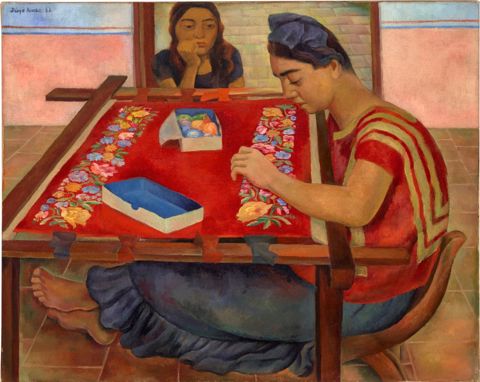Rediscovered Diego Rivera Painting Acquired by the Museum of Fine Arts, Houston
La Bordadora had been in the collection of one family for nearly a century until its purchase by the MFAH
HOUSTON—MARCH 11, 2022—The Museum of Fine Arts, Houston, has acquired a major, rediscovered painting by the great Mexican muralist Diego Rivera (1886–1957). The 1928 painting La Bordadora (The Embroiderer) had been in the collection of a New Orleans family since they acquired it, shortly after the work was completed. It has not previously been on public view.
“I am thrilled to announce the acquisition of this remarkable painting,” said Gary Tinterow, Director and Margaret Alkek Williams Chair of the Museum of Fine Arts, Houston. “La Bordadora relates thematically and stylistically to a beautiful Rivera cartoon already in the MFAH collection, from his iconic mural cycle at the Ministry of Education in Mexico City. Both La Bordadora and the ministry murals herald a fundamental theme of Rivera’s life’s work, to capture the dignity of the everyday. With this acquisition, we will be able to build on the foundations of our extraordinary holdings of 20th-century Latin American art to tell the story of Modernism from its earliest chapters.”
Rivera had gone to the region of Tehuantepec, near Oaxaca, Mexico, in 1923, and there discovered the vibrant, indigenous culture of Mexico, with its traditions passed down by women through generations. He created drawings as well as a few paintings of weavers and artisans. La Bordadora depicts two women in an abstracted interior at a table, with the woman in the foreground working on an embroidery panel.
The painting was acquired in 1928 or 1929 by James Kern Feibleman, a New Orleans businessman, and later a professor, who had been involved in literary and artistic circles in the city that overlapped and interconnected with those in Mexico. A photograph of the painting taken by Tina Modotti was published in 1930 in the Paris journal Art Vivant, but the painting’s location remained unknown until recently.
About the Museum of Fine Arts, Houston
Spanning 14 acres in the heart of Houston’s Museum District, the MFAH main campus comprises the Audrey Jones Beck Building, the Caroline Wiess Law Building, the Lillie and Hugh Roy Cullen Sculpture Garden, and the Nancy and Rich Kinder Building. Nearby, two house museums—Bayou Bend Collection and Gardens, and Rienzi—present collections of American and European decorative arts. The MFAH is also home to the Glassell School of Art, with its Core Residency Program and Junior and Studio schools; and the International Center for the Arts of the Americas (ICAA), a leading research institute for 20th-century Latin American and Latino art. Additional resources include a repertory cinema; two significant research libraries: the Hirsch Library and the Powell Library and Study Center at Bayou Bend; public archives; a conservation studio; and an off-site storage facility. The MFAH collections include in-depth holdings of Pre-Columbian and African gold, American art, European paintings, and distinguished international collections of modern and contemporary art. Particular strengths are in postwar American painting; postwar Latin American art, with a focus on Concrete and Constructive art from Brazil, Argentina and Venezuela, as well as contemporary photo-based work and large-scale installations; international photography, with notable concentrations in Japanese, Latin American, and Central European photography as well as American and Western European; prints and drawings, including the entire 1980–1994 archive portfolio of Peter Blum Editions; and international decorative arts, craft, and design, in particular contemporary.
Media Contact
Melanie Fahey, Senior Publicist
mfahey@mfah.org | 713.800.5345

